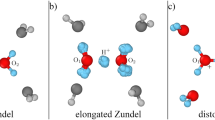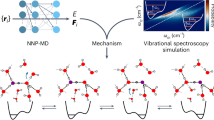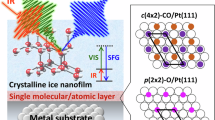Abstract
Proton transfer through hydrogen bonds plays a fundamental role in many physical, chemical and biological processes1,2,3,4,5. Proton dynamics is susceptible to quantum tunnelling, which typically involves many hydrogen bonds simultaneously, leading to correlated many-body tunnelling6,7,8,9. In contrast to the well-studied incoherent single-particle tunnelling, our understanding of many-body tunnelling is still in its infancy. Here we report the real-space observation of concerted proton tunnelling in a cyclic water tetramer using a cryogenic scanning tunnelling microscope. This is achieved by monitoring the reversible interconversion of the hydrogen-bonding chirality of the water tetramer with a chlorine-terminated scanning tunnelling microscope tip. We found that the presence of the Cl anion at the tip apex may either enhance or suppress the concerted tunnelling process, depending on the details of the coupling symmetry between the Cl ion and the protons. Our work opens up the possibility of controlling the quantum states of protons with atomic-scale precision.
This is a preview of subscription content, access via your institution
Access options
Subscribe to this journal
Receive 12 print issues and online access
$259.00 per year
only $21.58 per issue
Buy this article
- Purchase on SpringerLink
- Instant access to full article PDF
Prices may be subject to local taxes which are calculated during checkout




Similar content being viewed by others
References
Kreuer, K. D. Proton conductivity: Materials and applications. Chem. Mater. 8, 610–641 (1996).
Benoit, M., Marx, D. & Parrinello, M. Tunnelling and zero-point motion in high-pressure ice. Nature 392, 258–261 (1998).
Horiuchi, S. et al. Above-room-temperature ferroelectricity in a single-component molecular crystal. Nature 463, 789–793 (2010).
Frank, R. A. W. et al. A molecular switch and proton wire synchronize the active sites in thiamine enzymes. Science 306, 872–876 (2004).
Masgrau, L. et al. Atomic description of an enzyme reaction dominated by proton tunneling. Science 312, 237–241 (2006).
Brougham, D. F., Caciuffo, R. & Horsewill, A. J. Coordinated proton tunneling in a cyclic network of four hydrogen bonds in the solid state. Nature 397, 241–243 (1999).
Bove, L. E., Klotz, S., Paciaroni, A. & Sacchetti, F. Anomalous proton dynamics in ice at low temperature. Phys. Rev. Lett. 103, 165901 (2009).
Lin, L., Morrone, J. A. & Car, R. Correlated tunneling in hydrogen bonds. J. Stat. Phys. 145, 365–384 (2011).
Drechsel-Grau, C. & Marx, D. Quantum simulation of collective proton tunneling in hexagonal ice crystals. Phys. Rev. Lett. 112, 148302 (2014).
Gilli, G. & Gilli, P. The Nature of the Hydrogen Bond (Oxford Univ. Press, 2009).
Garczarek, F. & Gerwert, K. Functional waters in intraprotein proton transfer monitored by FTIR difference spectroscopy. Nature 439, 109–112 (2006).
Liljeroth, P., Repp, J. & Meyer, G. Current-induced hydrogen tautomerization and conductance switching of naphthalocyanine molecules. Science 317, 1203–1206 (2007).
Kumagai, T. et al. H-atom relay reactions in real space. Nature Mater. 11, 167–172 (2012).
Merte, L. R. et al. Water-mediated proton hopping on an iron oxide surface. Science 336, 889–893 (2012).
Auwärter, W. et al. A surface-anchored molecular four-level conductance switch based on single proton transfer. Nature Nanotech. 7, 41–46 (2012).
Kumagai, T. et al. Controlling intramolecular hydrogen transfer in a porphycene molecule with single atoms or molecules located nearby. Nature Chem. 6, 41–46 (2013).
Lawton, T. J. et al. Visualization of hydrogen bonding and associated chirality in methanol hexamers. Phys. Rev. Lett. 107, 256101 (2011).
Zhang, J. et al. Real-space identification of intermolecular bonding with atomic force microscopy. Science 342, 611–614 (2013).
Chiang, C. L. et al. Real-space imaging of molecular structure and chemical bonding by single-molecule inelastic tunneling probe. Science 344, 855–888 (2014).
Guo, J. et al. Real-space imaging of interfacial water with submolecular resolution. Nature Mater. 13, 184–189 (2014).
Ho, W. Single-molecule chemistry. J. Chem. Phys. 117, 11033–11061 (2002).
Gawronski, H. et al. Manipulation and control of hydrogen bond dynamics in absorbed ice nanoclusters. Phys. Rev. Lett. 101, 136102 (2008).
Lauhon, L. J. & Ho, W. Direct observation of the quantum tunneling of single hydrogen atoms with a scanning tunneling microscope. Phys. Rev. Lett. 85, 4566–4569 (2000).
Leggett, A. J. et al. Dynamics of the dissipative two-state system. Rev. Mod. Phys. 59, 1–85 (1987).
Horsewill, A. J. Quantum tunnelling in the hydrogen bond. Prog. Nucl. Magn. Reson. Spectrosc. 52, 170–196 (2008).
Drechsel-Grau, C. & Marx, D. Exceptional isotopic-substitution effect: Breakdown of collective proton tunneling in hexagonal ice due to partial deuteration. Angew. Chem. 126, 11117–11120 (2014).
Ding, Y., Hassanali, A. A. & Parrinello, M. Anomalous water diffusion in salt solutions. Proc. Natl Acad. Sci. USA 111, 3310–3315 (2014).
Kresse, G. & Hafner, J. Ab initio molecular dynamics for liquid metals. Phys. Rev. B 47, 558–561 (1993).
Kresse, G. & Joubert, D. From ultrasoft pseudopotentials to the projector augmented-wave method. Phys. Rev. B 59, 1758–1775 (1999).
Klimeš, J., Bowler, D. R. & Michaelides, A. Van der Waals density functionals applied to solids. Phys. Rev. B 83, 195131 (2011).
Henkelman, G., Uberuaga, B. P. & Jónsson, H. A climbing image nudged elastic band method for finding saddle points and minimum energy paths. J. Chem. Phys. 113, 9901–9904 (2000).
Acknowledgements
This work was supported by the National Basic Research Programs of China under Grant Nos 2012CB921303, 2012CB921304 and 2013CB934600, the National Science Foundation of China under Grant Nos 11104004, 11274012, 91021007, 91321309, 11290162/A040106 and 11275008. Y.J. acknowledges support from the National Program for Support of Top-notch Young Professionals. We are grateful for the computational resources provided by the supercomputer TianHe-1A in Tianjin, China. We thank Z. H. Cheng, A. H. Castro Neto, M. F. Crommie and A. Hodgson for enlightening discussions.
Author information
Authors and Affiliations
Contributions
Y.J. and E-G.W. designed and supervised the project. X.M., J.G. and Y.J. performed the STM measurements. J.C. and X-Z.L. carried out the DFT calculations. J.P., J.G., X.M., Z.W., and Y.J. analysed the data. J-R.S. contributed to the interpretation of the data. Y.J. and X.M. wrote the manuscript with J.G., J.P., J.C., X-Z.L. and E-G.W. The manuscript reflects the contributions of all authors.
Corresponding authors
Ethics declarations
Competing interests
The authors declare no competing financial interests.
Supplementary information
Supplementary Information
Supplementary Information (PDF 11937 kb)
Supplementary Movie
Supplementary Movie 1 (MOV 1451 kb)
Supplementary Movie
Supplementary Movie 2 (MOV 842 kb)
Rights and permissions
About this article
Cite this article
Meng, X., Guo, J., Peng, J. et al. Direct visualization of concerted proton tunnelling in a water nanocluster. Nature Phys 11, 235–239 (2015). https://doi.org/10.1038/nphys3225
Received:
Accepted:
Published:
Issue date:
DOI: https://doi.org/10.1038/nphys3225
This article is cited by
-
Ortho-para interconversion of nuclear states of H2O through replica transition state: prospect of quantum entanglement at homodromic Bjerrum defect site
Journal of Molecular Modeling (2023)
-
Infrared spectroscopic study of hydrogen bonding topologies in the smallest ice cube
Nature Communications (2020)
-
Weakly perturbative imaging of interfacial water with submolecular resolution by atomic force microscopy
Nature Communications (2018)
-
The effect of hydration number on the interfacial transport of sodium ions
Nature (2018)



